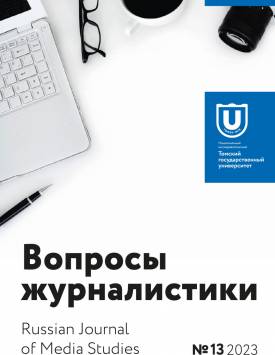Linguistic reflection in the reportage by Dmitriy Sokolov-Mitrich
The article presents the history of the study of individual style of Dmitriy Sokolov-Mitrich. We note the insufficient knowledge of metatext in journalistic works. Analyzing reportages by Sokolov-Mitrich, we determine the main functions of reflexives in them: (1) text-forming function, 2) function of creating communicative environment, (3) characterological function. We propose a typology of reflexives with identifying subjects, objects, content, and forms of linguistic reflection. The subject of linguistic reflection in a reportage is the author, the hero or a third person. The object is a word, a phrase or a statement, as well as the manner of speaking, the acoustic effect, communication habits of the hero, etc. Vocabulary of limited use (regional, professional, slang) and of foreign origin, abstract vocabulary, proper names (anthroponyms: personal names, including nicknames of foreign origin, toponyms), as well as precedent phenomena are marked. The content of me-tatextual comments is reduced to interpreting the meaning of the marked units (through definition, context, selection of a synonym or a metaphor), searching for an equivalent in another language, and selecting the most appropriate lexical and semantic option. Forms of linguistic reflection are explicit (expressed through linguistic means on the text, sentence, or word level) and implicit (hidden). The most frequent form in Sokolov-Mitrich's reportages is the indefinite-personal construction, as well as the authorization modal particle and the meta-operator modal word. The latent form or intertextuality is a direct or indirect reference to another text. We consider the nonverbal form of metatext (expressed by paralinguistic means: italics, font, special design of intratextual headings and quotations) as a form intermediate between explicit and implicit forms. The so-called “fictitious” metatext (clarification of genre, summarized evaluaion of one's own text, spoiler) has the function of drawing the reader's attention to the author's intention. The features of Sokolov-Mitrich's individual style are identified: attention to the meaning and sound of the word, language play and, at the same time, conciseness of expression and concentration of meanings. The conclusion summarizes the results and outlines the perspectives of the study. The future of the study, in our opinion, can be outlined in terms of both exploring the individual style of a particular author and the linguistic specificity of the genre, and developing the theory of the metatext. A comparison of the means of creating portraits/images in nonfiction and fiction also seems prospective.
Keywords
Dmitriy Sokolov-Mitrich, individual style, media stylistics, reportage, portrait journalism, reflexives, function of creating communicative environmentAuthors
| Name | Organization | |
| Vysotskaya Irina V. | Novosibirsk State University | i.vysotskaia@g.nsu.ru |
| Gudchenko Leonid A. | Novosibirsk State University | l.goudchenko@g.nsu.ru |
References

Linguistic reflection in the reportage by Dmitriy Sokolov-Mitrich | Voprosy zhurnalistiki – Russian Journal of Media Studies. 2023. № 13. DOI: 10.17223/26188422/13/5
